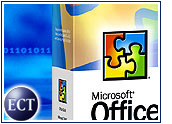
Now that Bill Gates and company have vacated Manhattan’s Millennium Hotel after their much-publicized launch of Office 2003, many people are asking whether Microsoft’s venerable productivity suite is indeed the Office of the new millennium — or whether they will stick with their present version of the software (or a competing product) until Microsoft’s Windows overhaul, nicknamed “Longhorn,” is released in late 2005 or early 2006.
“From a pure feature standpoint, [Office 2003] has not changed much,” Meta Group analyst Steve Kleynhans told the E-Commerce Times. “There is a long list of subtle enhancements, and Microsoft has polished up a few more things, but most people using Office XP will be somewhat underwhelmed by new version.”
Kleynhans said the decision to migrate to Office 2003 from another productivity suite or from an earlier iteration of Office ultimately hangs on two questions, one tactical and one strategic.
Improved Plumbing and Interface
He said Office 2003 is centered on a series of information worker-focused capabilities that link traditional applications with a collaborative infrastructure.
For example, Office 2003’s new Shared Workspace Task Pane allows enterprise employees to search for updated versions of files, find out if fellow coworkers are online and check for related links and files. Moreover, the task pane offers the capability of getting e-mail alerts whenever any item in the shared workspace is altered or updated.
Office 2003 Pro, Microsoft’s enterprise version of its new business system, also comes with InfoPath, Kleynhans pointed out. InfoPath lets users create and complete dynamic forms and submit them to XML-enabled systems and business processes.
On a plumbing level, Microsoft has squared away all of its XML support, Kleynhans said.
“It really gels with this release, and Microsoft is now positioning it as a useful tool to move information back and forth between the Office suite and other business systems that are XML-enabled,” he noted. “It is much more straightforward and more robust” than previous versions, which positioned XML support as more of a development tool.
Switch Tactics
On a tactical level, an IT department likely would decide to upgrade to Office 2003 if the company’s current version of Office is obsolete or if it is causing immediate, specific problems with the work the company is doing.
For example, Microsoft is no longer supporting Office 97, so enterprises that still are using this version may find it is in their interest to switch. Also, an enterprise upgrading its PCs to the Windows XP operating system might view upgrading to Office 2003 as a logical next step, Kleynhans said.
On the other hand, organizations that already are using Office XP probably will stay with it for a few more years, while those using Office 2000 might upgrade, though at a more leisurely pace.
Kleynhans noted that when making a strategic upgrade decision, companies need to ask themselves how they plan to use Office in the future.
If, in setting up a collaborative work environment, an enterprise shares Microsoft’s vision, then Office 2003 is a compelling solution, he said. By migrating to the new software, enterprises can begin laying a foundation for this collaborative setup, so that by the time Longhorn launches, they will be used to how some of the features work and their efforts will come to fruition.
Challengers to the Throne
Of course, Microsoft is not the only software vendor offering a productivity suite. Other options include Corel’s WordPerfect, still used by many in the legal community; OpenOffice, an open-source solution for Windows and Linux; and Sun’s StarOffice.
Kleynhans said that when it comes to basic functionality in word processing, spreadsheets and presentation tools, most productivity suites have reached parity. He added that Microsoft is still leading the pack, although its many features can be overkill for many users.
However, compatibility may be the primary determinant of whether to migrate to another product or remain with Microsoft. The costs of switching vendors and retraining personnel, along with a general lack of compatibility, may make the switch to other vendors too problematic.
Moving Target
Indeed, Dan Kusnetzky, vice president of systems software research at IDC, told the E-Commerce Times that vendors of open-source alternatives like OpenOffice and StarOffice face a formidable challenge: Microsoft has made its Office formats a sort of moving target.
Because so much of Office’s code is proprietary in nature, Kusnetzky explained, the software giant alters code ostensibly to change features and functions, but also to stymie competitors in their attempts to be interoperable.
However, he added that despite obstacles, both StarOffice and OpenOffice have improved their interoperability with Microsoft dramatically over time, to the point that each product offers at least 95 percent compatibility with Microsoft Office.
For example, Kusnetzky said he recently sent an Office document, which contained sophisticated templates that IDC uses to facilitate writing and editing, to an open-source vendor. The company read, commented on and returned the document to him, and he then was able to open, read and respond to it using Microsoft Office.
Viable Alternatives?
Kusnetzky noted that Microsoft’s own business rules and practices could be driving customers to seek alternatives. In addition, there are hefty price differentials (Sun’s full-featured StarOffice, which comes with complete support and upgrades, costs US$79 per seat, while Office Pro 2003 costs $450 per seat).
However, not all companies can simply abandon the industry standard. For example, more and more law offices are migrating to Microsoft Office, despite having a long-standing community of WordPerfect users. Meta Group’s Kleynhans attributes this switch to legal professionals’ need to communicate effectively with clients, most of whom use Microsoft software.
A middle ground may exist. Kusnetzky recommended that enterprises segment their organizations by what people do and how they do it to determine whether open-source office productivity suites are viable alternatives. Certain employees, such as developers and transactional employees, could switch to alternatives now without denting their productivity, he said. On the other hand, knowledge workers who need to interface with outside companies or customers may be locked into Microsoft Office for years to come.
























































Social Media
See all Social Media